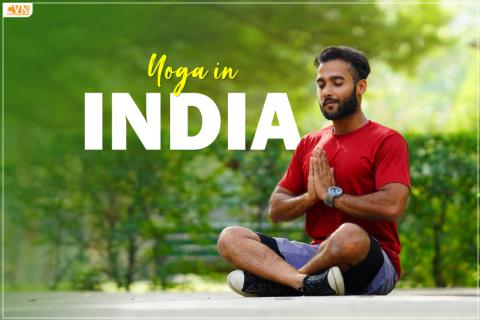Narasimha:
Narasimha, sometimes referred to as Narasingha, is the fourth avatar of the Hindu god Vishnu. This unique incarnation, part-human and part-lion, was manifested to defeat the demon king Hiranyakashipu, thereby ending religious persecution and restoring dharma on Earth.
Yoga Narasimha:
Yoga Narasimha represents a revered form of Vishnu’s fourth avatar, combining both dynamic energy and deep tranquility. While Narasimha is usually depicted as a fierce deity who destroys the demon Hiranyakashipu, his Yoga Narasimha form emphasizes a quieter, more contemplative side, focusing on meditation, inner peace, and self-discipline.
Iconography and Symbolism:
In the Yoga Narasimha form, the deity is often depicted seated in the lotus position (Padmasana), a traditional yogic pose that symbolizes spiritual enlightenment and balance. His lion-like face, which radiates raw power, contrasts with the calmness of his meditative posture, illustrating the harmonious blend of strength and tranquility. His eyes are usually shown half-closed or gently focused inward, symbolizing deep concentration and the inward journey toward self-realization.
This form is adorned with typical attributes of a yogi: a serene expression, mudras (hand gestures) symbolizing peace and meditation, and sometimes surrounded by an aura of divine light. The combination of fierce and peaceful elements in Yoga Narasimha’s imagery underscores the idea that true strength is tempered by inner calm and discipline.
Click here to buy this idol of Yoga Narasimha.
Appearance and Pose of Yoga Narasimha:
Yoga Narasimha, a distinct form of Vishnu's fourth avatar, merges the intense characteristics of traditional Narasimha with a serene, meditative demeanor. Here is a detailed description of his appearance and pose:
Body and Posture:
Yoga Narasimha is commonly depicted seated in the lotus position (Padmasana), a pose symbolizing meditation and spiritual enlightenment. His upper body is upright and composed, exuding a sense of tranquility and control. This posture highlights the themes of inner peace and yogic focus.
Face and Expression:
His face retains the lion-like features of lord Narasimha swamy, with a prominent mane, sharp eyes, and a fierce expression. However, in the Yoga Narasimha form, these features are softened to convey calmness and introspection. His eyes are often closed or gently focused inward, indicating deep meditation.
Hands and Mudras:
The hands of Yoga Narasimha are usually positioned in symbolic gestures or mudras. Common mudras include:
Dhyana Mudra: The gesture of meditation, where the hands rest on the lap with palms facing upward, one over the other, and thumbs touching.
Abhaya Mudra: The gesture of fearlessness and protection, where the right hand is raised to shoulder height with the palm facing outward.
Varada Mudra: The gesture of granting boons, where the left hand is extended downward with the palm open, facing outward.
Explore our collections in idol, Figurines, Artefacts, Monuments
Ornaments and Adornments:
Yoga Narasimha is richly decorated, signifying his divine nature and the blend of majesty and meditation:
Crown (Mukuta): He wears an ornate crown, often adorned with intricate designs and jewels, symbolizing his royal and divine status.
Garlands and Necklaces: Multiple layers of necklaces and garlands adorn his neck, usually made of gold and embedded with precious gems, emphasizing his divine opulence.
Armlets and Bracelets: His arms are adorned with intricately designed armlets (bajuband) and bracelets, which are embellished with jewels.
Sacred Thread (Yajnopavita): A sacred thread is often seen draped across his chest, symbolizing his adherence to Vedic traditions and spiritual authority.
Ankle Bells (Nupura): His ankles are decorated with delicate bells, adding a musical element to his divine presence.
Clothing: His attire includes rich, flowing garments, often depicted in vibrant colors such as red, yellow, or saffron, symbolizing divine energy and spirituality. The garments are adorned with golden borders and intricate patterns.
Lotus Pedestal: Yoga Narasimha is often shown seated on a lotus pedestal, symbolizing purity and divine origin. The lotus represents spiritual awakening and enlightenment, further emphasizing the meditative aspect of this form.
Spiritual Significance:
Yoga Narasimha carries deep spiritual significance, highlighting the importance of inner strength and meditation. This form of Narasimha encourages devotees to turn inward to find peace and overcome their inner demons. It teaches that the path to enlightenment and true strength lies in mastering one's own thoughts and emotions through yoga and meditation.
As the God of Yoga, Yoga Narasimha guides practitioners on their spiritual journey, helping them balance their physical, mental, and spiritual energies. This form is especially revered for its ability to bestow inner peace, resilience, and spiritual clarity, making it a beloved deity for those seeking to deepen their yoga practice and spiritual discipline.
Yoga narasimha | Lord narasima in yoga mudhra Eco Plastic 6"
Temples and Worship:
Yoga Narasimha is worshipped in many temples across India, where his devotees seek blessings for spiritual growth, inner peace, and strength. The Parakala Matha in Mysuru is one of the prominent centers dedicated to this form, reflecting its deep significance within the Sri Vaishnava tradition. Devotees often perform special rituals, meditations, and yoga practices in these temples, invoking Yoga Narasimha's blessings for guidance and protection.
Cultural and Philosophical Impact:
The depiction of Narasimha in a meditative yogic posture serves as a powerful bridge between the philosophies of Vaishnavism and Yoga. It emphasizes that divine intervention and personal spiritual practice are interconnected, and that one's inner spiritual journey is as crucial as external actions. Yoga Narasimha inspires practitioners to cultivate a calm and focused mind, reminding them that true strength comes from within.
This form of Narasimha Perumal also highlights the philosophical concept that all beings possess both fierce and peaceful aspects. By balancing these dualities through yoga and meditation, individuals can achieve harmony and enlightenment. Yoga Narasimha's teachings encourage devotees to embrace their inner strength while maintaining serenity and balance in their lives.
Visit Us for Unique Artefacts
Festivals Celebrated for Lord Narasimha:
Narasimha Jayanti:
Description: Narasimha Jayanti is the most important festival dedicated to Lord Narasimha, celebrating his appearance day. It falls on the 14th day of the bright half (Shukla Paksha) of the month of Vaishakha (April-May) in the Hindu calendar.
Rituals: Devotees observe fasting, perform special prayers, and engage in elaborate rituals in temples dedicated to Narasimha. The day is marked by the recitation of hymns and scriptures associated with Narasimha, such as the Narasimha Kavacham, and by performing abhishekam (ritual bathing) of Narasimha idols.
Vaikuntha Ekadashi:
Description: Primarily a festival dedicated to Lord Vishnu, Vaikuntha Ekadashi is also significant for devotees of Lord Narasimha. It falls on the 11th day of the waxing moon in the month of Margashirsha (December-January).
Rituals: Devotees fast and engage in various devotional activities, including chanting and meditation. Special prayers and rituals are conducted in Narasimha temples, and many devotees stay awake all night, singing hymns and participating in spiritual discourses.
Holi:
Description: Known as the festival of colors, Holi is also associated with the legend of Prahlada and Hiranyakashipu. It commemorates the protection of Prahlada by Lord Narasimha and the burning of Holika, Hiranyakashipu's sister.
Rituals: The festival is celebrated with colorful powders, singing, dancing, and festive foods. On the eve of Holi, bonfires are lit to symbolize the victory of good over evil, mirroring the burning of Holika and the protection of Prahlada by Narasimha.
Narasimha Vratam:
Description: This is a special fasting ritual observed by devotees to seek the blessings of Lord Narasimha for protection and the removal of obstacles. It can be performed on any auspicious day, but is often observed on specific days associated with Narasimha.
Rituals: Devotees observe a strict fast, perform elaborate pujas, and recite the Narasimha Stotra and other related hymns. The vratam is believed to bestow prosperity, health, and protection from evil.
Swati Nakshatra Celebrations:
Description: The star Swati is considered auspicious for Lord Narasimha, and special prayers and rituals are performed in temples on the day when the Swati Nakshatra is prominent.
Rituals: Devotees visit Narasimha temples, perform special abhishekam, and offer prasad (sacred food). Many devotees undertake fasting and engage in chanting the Narasimha mantra.
The festivals dedicated to Lord Narasimha reflect the deep reverence and devotion that his followers have for this powerful avatar of Vishnu. Through these celebrations, devotees commemorate his divine intervention in protecting his devotees, upholding dharma, and vanquishing evil. Each festival is marked by vibrant rituals, fasting, prayers, and a deep sense of spiritual connection with Lord Narasimha.
Yoga Narasimha, the meditative form of Vishnu's fourth avatar, represents the perfect balance of power and serenity. This unique depiction of Narasimha highlights the union of fierce protective strength with deep spiritual calmness, teaching that true divinity encompasses both the might to protect and the wisdom to meditate. Worshipping Yoga Narasimha inspires devotees to seek protection and guidance, fostering a life where courage and calmness coexist harmoniously. This profound symbolism encourages the pursuit of spiritual enlightenment and the cultivation of inner harmony amidst life’s challenges.












